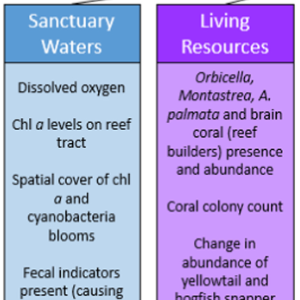Ecosystem indicators are a well-established method for tracking ecosystem conditions and trends with the purpose of informing ecosystem-based management. The selection of indicators is a key step in the management process; however, because 1) selection can be inherently subjective 2) researchers can be entrenched in the ecosystem components they routinely measure, and 3) some voices may be marginalized in a group setting, the selection, prioritization, and consensus processes can be challenging. To overcome these issues, an indicator selection process was developed herein that incorporated expert opinion both qualitatively and quantitatively. The decision matrix asked experts to provide weighted values for each selection criterion and a score of how well each potential indicator fit each criterion. The score of how well the indicators fit the criterion was multiplied by the weight given to that criterion, then summed for all criteria, resulting in an overall score of how well a potential indicator fit the criteria. The indicator scores were then ranked using all experts’ scores to develop a single best-fit list of indicators. The approach was pilot-tested to select indicators for the Florida Keys National Marine Sanctuary (FKNMS), creating a prioritized list of indicators that best reflected the condition of the FKNMS resources, ecosystem services, and pressures. Specifically, 56 indicators were found to best model the status and trends associated with 16 standard questions regarding condition of national marine sanctuaries. This process is directly transferable to other national marine sanctuaries, and also identifies data gaps. The criteria can be modified to make the selection process applicable to a wide range of ecosystem-based management applications in both marine and terrestrial ecosystems. This method provides a means of selecting indicators that minimizes the effects of group dynamics on consensus.
A quantitative and qualitative decision-making process for selecting indicators to track ecosystem condition
Publication date
July 01, 2021
Abstract
Journal
Marine Policy, Volume 129, July 2021, Article 104489.
DOI
https://doi.org/10.1016/j.marpol.2021.104489
Region
Gulf of America


